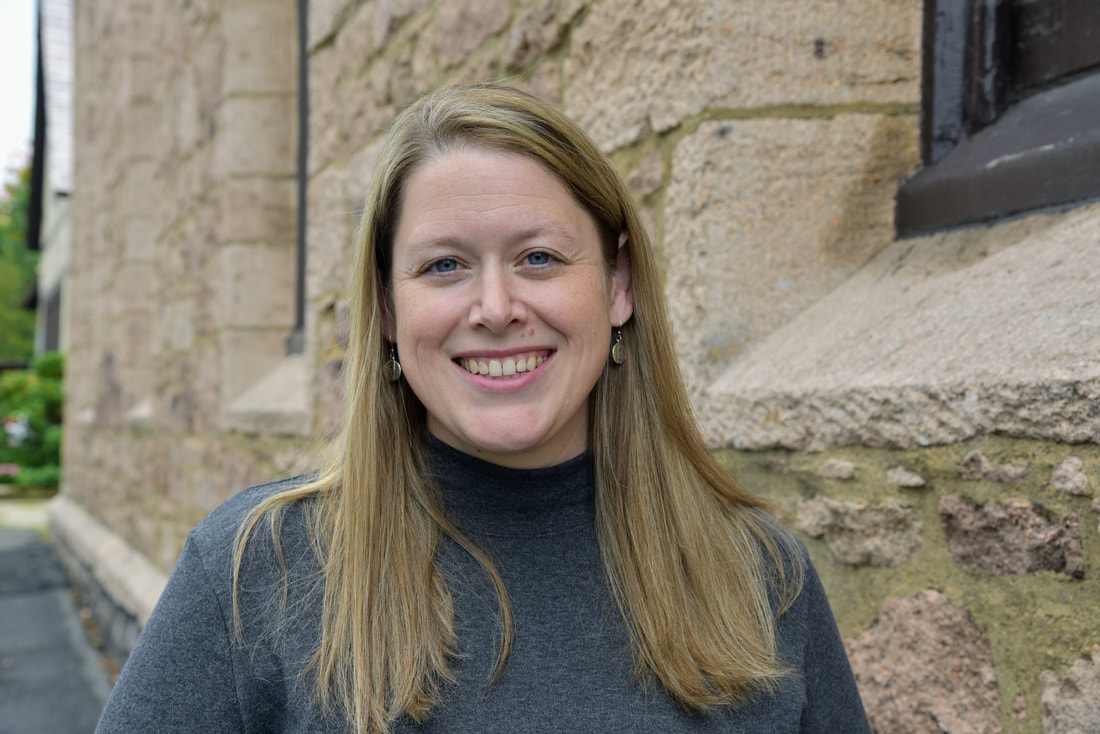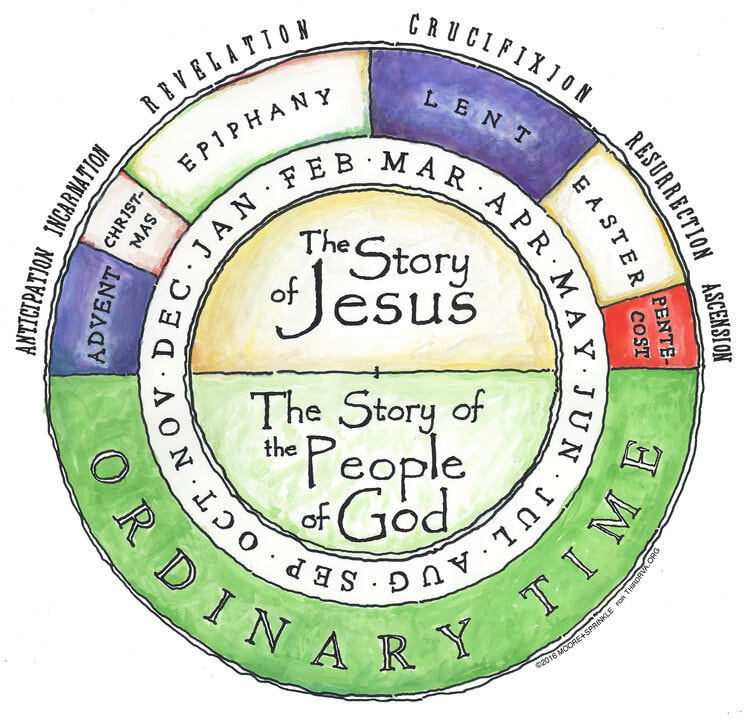One church in Virginia created a visual of how the Church marks time, and they made the image widely available for other communities.3 You’ll see in this image that the church year is a circle, ever in motion. At the heart of the circle are two halves:
The Story of Jesus and The Story of the People of God. We spend roughly six months in each. You’ll notice the ring around the inner circle reflects secular time, beginning in December and ending in November. While we might find it unusual that the Church calendar is at odds with our secular calendar, I think it is another reminder about who we are. As followers of Christ walking the way of love, our priorities are coming together to proclaim God’s dream for this world by being the hands and feet of Christ in our communities. On a daily basis, striving to turn this world upside down and right side up again by loving ourselves and our neighbors, as God loves us. This often puts us at odds with the priorities of the wider culture--which place a high value on productivity, consumerism, and individualism. The Church calendar being out of sync with the secular calendar reminds us that being a follower of Christ is going to put us out of sync with the wider culture. And that’s just as it ought to be. You’ll notice the next ring of the circle marks the liturgical seasons. There are six short seasons during the first half of the year when we focus on the story of Jesus. Then just outside the circle, on the top half, is one word describing each season. The year begins with Advent; a season of anticipation. During these four weeks, we watch the shadows lengthen, eagerly awaiting and remembering when a bright light burst into our troubled world, all those years ago, as a newborn child, and will come again someday in glory. We shift to the color blue in our vestments and frontals, and use an advent wreath to mark our time; lighting an additional candle each week. The readings assigned from the Hebrew Bible are drawn from Isaiah, foreshadowing the coming Messiah, while the Gospel readings emphasize the work of John the Baptist, preparing the way for the coming Christ. Here again we find the church calendar at odds with the secular calendar. As the wider culture goes into overdrive consuming more food, alcohol, presents, parties, and countless other ways of over functioning, the Church is asked to slow down. To be still; to wait mindfully for the Christ-child. As followers journeying the way of love, we seek to live into the tension of these competing priorities. Following Advent are the twelve days of Christmas, where the colors shift to a bright gold or white. Starting with the Feast of the Nativity we begin a celebration of God’s incarnation. The magnificent and humbling reality that the Creator of the cosmos was also willing to be born as one of us; to live, suffer, love and die as one of us.I once heard a theologian describe how different denominations seem to find one aspect of the story of Jesus more meaningful than others. He argued that for Episcopalians, it was the act of the incarnation itself that mattered most-- the very fact that our God would embody love for us in human flesh. If God did nothing else, this one act was enough to change everything. Christmas is followed by Epiphany, a season of revelation. On the Feast of the Epiphany, we remember the arrival of the magi, who travelled from a distant land following a star to find the Christ-child. Throughout the season, the readings recall the many ways Jesus was revealed to people-- from his baptism, to the calling of the disciples, to the transfiguration. The season emphasizes Jesus’ mission to bring God’s dream to the whole of creation. We use gold or white for the Feast of Epiphany, and green throughout the rest of the season. Next is the season of Lent, which begins on Ash Wednesday. We are marked with ashes, reminding us of our mortality. From there we spend the next forty days tending to our relationship with God. We practice greater self-discipline than we might ordinarily, attempt to live simpler lives, and spend more time in prayer and devotion. Another season of feeling the tension between the priorities of the wider culture and the priorities for followers of the way of love. It is a season of remembering that sometimes we lose our way, yet God is always there with us, ready to continue the journey. We see this theme in the readings, as God and the Israelites wander together in the wilderness, and with Jesus during his own wilderness time. Purple is the color for the season, which you’ll notice in the clergy’s vestments. Though here at James and Andrew, we have a dark red and creme frontal, which were once the colors of Lent. Then on Palm Sunday we begin our journey through Holy Week, remembering Jesus' final days. During that week we use red on Palm Sunday, white on Maundy Thursday, and on Good Friday we simply let the bare wood of the altar speak for itself. Yet the very next evening a new season begins with the Great Vigil of Easter, where we rejoice in the news of an empty tomb and the resurrected Christ. We proclaim the good news that love will always conquer death. Our worship begins in darkness, until the new fire is lit and we recall the sacred story of God’s relationship with humanity, which culminates in the story of Jesus’ resurrection and the return of light into our world. Throughout the fifty days of the season we use gold or white, and the readings remind us of the disciples' various encounters with the resurrected Christ and what all this meant for followers of the way of love. All of this leads up to Christ’s ascension on the Feast of the Ascension, and the arrival of the Holy Spirit on the Feast Day of Pentecost. We wear red, and celebrate the birth of the Church. From there we enter the second half of the year, Ordinary Time. The very long season of green. Ordinary Time is our response to the story of Jesus. In scripture, we hear story after story of the people of God, as we navigate the ins and outs of walking the way of love. In some of the stories we get it right, and embody the very best of God’s love and are engaging in the work of transforming the world into what God always knew we could be. Other times, we get sidetracked or self-involved, and are given growth opportunities that we may or may not have asked for. This is our story of doing our best to walk the way of love. During ordinary time there are two principal feasts: Trinity Sunday, where we recognize the threefold nature of God; and All Saints Day, where we honor the multitude of saints whose lives inspire and encourage us in our journey of faith. Trinity Sunday is the first Sunday after Pentecost, and All Saints falls near the end of ordinary time in November. Yet the rest of the season is rather flat and, well, ordinary. There are no great spiritual highs and lows. This is important because it reminds us that the work of faith is an everyday kind of thing, not just for those special seasons and days. You’ve heard me mention some feast days. These are known as Principal Feasts-- Christmas, Epiphany, Easter, Ascension, Pentecost, Trinity Sunday, and All Saints. There are also regular feast days. Do you know when these days are? If you guessed every Sunday of the year, you guessed correctly. There are many other holy days throughout the year: special days in the life of Jesus, remembering the apostles, and days of fasting, such as Ash Wednesday and Good Friday. In addition to this there are also a great many other special commemorations in Lesser Feasts and Fasts and A Great Cloud of Witnesses, if you are interested in learning more about holy days. This was rather a birds eye view of the church calendar and liturgical year, and if you are interested in learning more about a particular aspect, please be sure to let me know and we’ll keep it in mind for a future topic. If there is one thing you take away from today, I hope it is that our liturgy, our work of bringing about God’s dream in this world is centered and grounded in the life, death, and resurrection of Jesus. We mark time with the story of Jesus and our response to it. As we head into the week before us, I’d encourage us each to consider: When in the church year do you find your life most in tension with the priorities of the wider culture? What is your favorite liturgical season and why?4 How do these special seasons and holy days deepen our relationship with God?5 Amen.
|
We are blessed to have a diversity of preaching voices in our parish. Our guild of preachers is a mixture of lay and clergy. We hope you enjoy the varied voices. Meet our Preachers
All
Archives
July 2024
|

